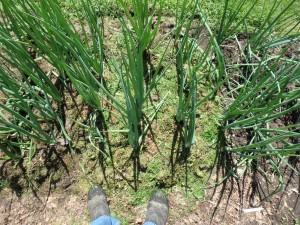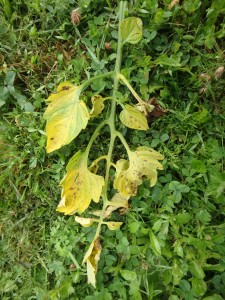Mid-summer Tasks in the Garden
By now my gardens are well established and most plants are doing well. But there are tasks, both in the vegetable garden and in the flower beds, that need my attention.
Weeding is key in both areas, and recent rains make doing so easier as the soil has softened up. If you have very dry soil where you are, you might want to water well before weeding.
Why worry about weeds? I know gardeners who don’t do much weeding in their vegetable gardens. One even told me that if he weeded too much the deer would find his vegetables! But weeds anywhere in the garden are going to spread seeds soon – whether in the walkways or up close to your tomatoes. And seeds will come back to make more work now – and in the years to come. Many weed seeds act like time release capsules, some germinating now, some later, some 5 years down the road.
Weeds compete with your plants for moisture, soil nutrients – and even sunshine as they get bigger. I use a CobraHead hand weeder (www.CobraHead.com). It’s shaped a bit like a curved finger with a sharp pointy spade-shaped tip about an inch across. It easily gets under weeds so that I can pull from above (with one hand) and from below (with the CobraHead) at the same time, or tease long roots out of the soil without breaking them.
Thinning your carrots, beets and other root crops is an urgent job if you haven’t done so yet. Like weeds, vegetables growing too close to one another will compete for sun, water and nutrients. Carrots and beets should be at least an inch apart by now. And in a month, you need to thin them to 2 inches apart. Pulling the sharp tip of a CobraHead alongside a row of carrots will loosen the soil, sever a few side-growing roots, encouraging those that go deep. And scratch in some organic fertilizer now, too. It will help you get bigger carrots.
By the way, you can transplant carrots as you thin them out. Poke a hole deep enough so that the carrot will not bend, drop it in, press down the soil, water. It’s not a 100% reliable technique, but I hate to kill plants and have found it works most of the time. Do it in the evening, so they will have all night to recover before the hot sun hits them.
My onion patch was recently weeded, but I know that weeds will be along soon. So I mulched my onions with grass clippings. I find they work better than straw or hay in tight quarters like the onions. And green clippings may add a little nitrogen to the soil as they break down.
In many gardens the lower leaves of tomatoes are starting to yellow and develop dark blotches, sure signs of early blight. Although this blight is not immediately fatal, it reduces crop yield. By the end of August stems are often bare of leaves. You can minimize it by pruning off the affected leaves and all lower branches that touch the soil or are near it. Work on your plants when they are fully dry as the disease spreads more easily when leaves are wet.
I use scissors to remove the leaves, dipping them frequently in a glass of rubbing alcohol to sterilize them between plants. I wash my hands in a bucket of soapy water between plants. To see an in-depth article about this procedure along with many pictures, go to https://dailyuv.com/news/
I always plant my potatoes in June, even though many gardeners start planting them in April. I do this as I ‘ve found that I have fewer potato beetles by planting late. Maybe they’re all at my neighbors’ gardens. But do take some time to check yours to see if any beetles are eating the leaves. Look for larvae, and for orange egg masses on the underside of leaves.
When you plant your potatoes the roots will grow down below the seed potatoes and the new potatoes will form above them. Now is a good time to add soil over the developing potatoes. This is known as hilling them. I plant mine using a post hole digger, so it’s easy to fill in above my seed potatoes, just pushing the soil from mounds next to each plant. You can also use a hoe and scrape soil from the walkways. Don’t worry if some leaves get buried. They won’t complain.
In my flower gardens I am mainly weeding and cutting back flowers stems that have already blossomed. Weeding gives me space to plant new flowers – even though I have an extensive palette of plants, I constantly go to garden centers to see new things, or plants I once had that have disappeared. (Yes, I kill a lot of plants, we all do).
Cutting off spent flowers is good. Important. It takes a lot of energy to produce seeds. By pruning back the spent flowers, your plants have more energy to develop good roots and strong stems.
So get outside and enjoy summer and pull some weeds. You garden will look better and you’ll feel better, too.
Henry is a UNH Master Gardener and the author of 4gardening books. His website is www.Gardening-Guy.com. Read his twice-weekly blog athttps://dailyuv.com/




